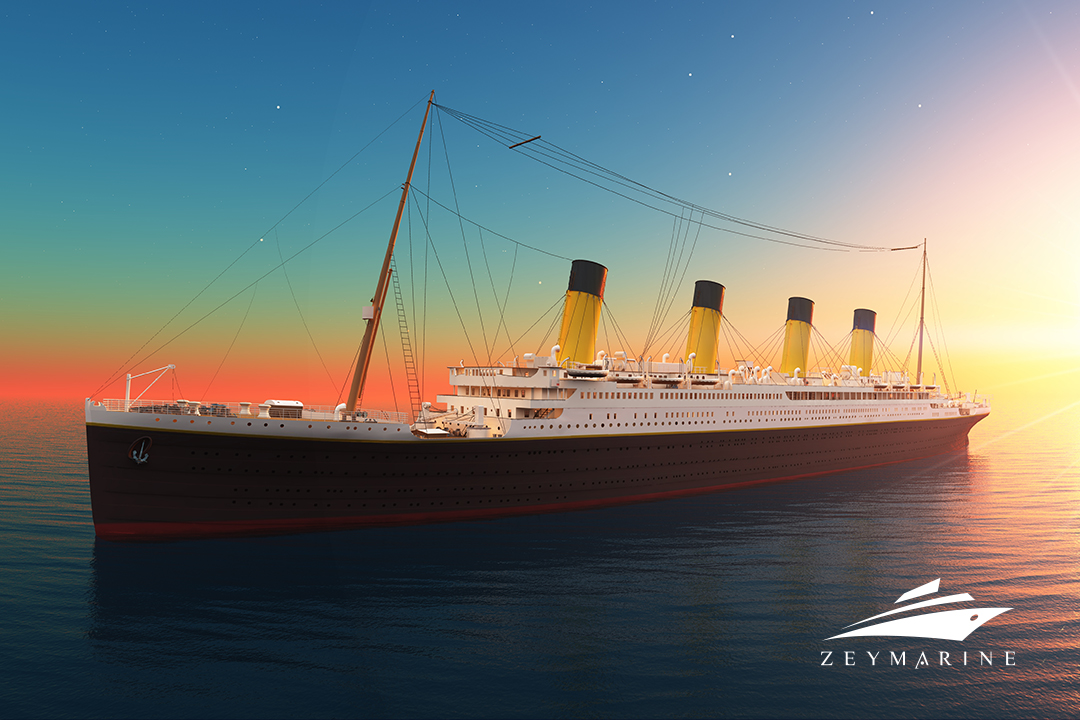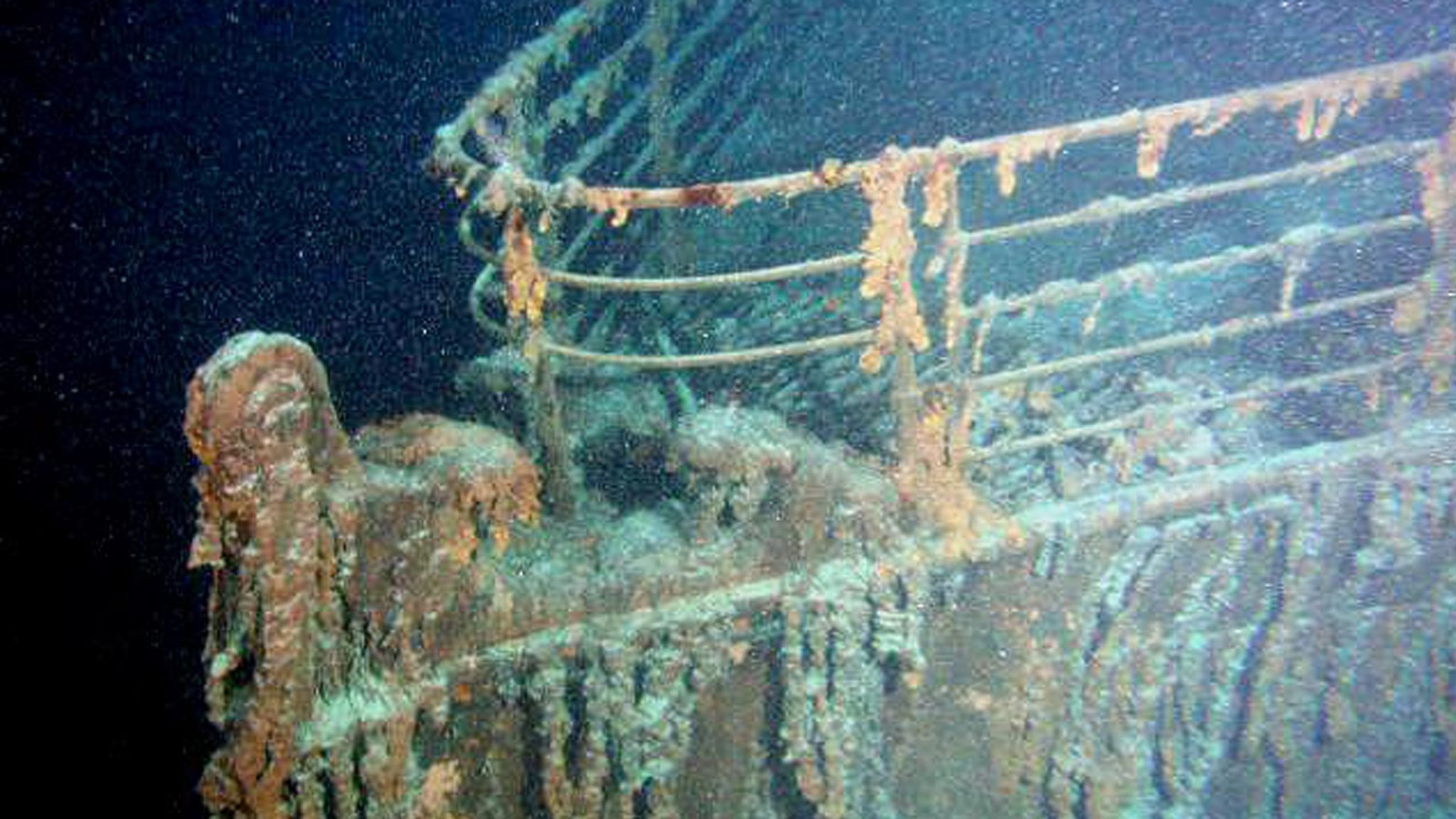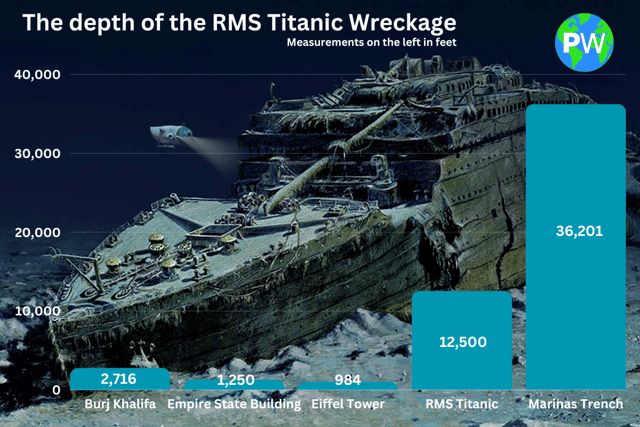First, for the refugees who capsized near the Peloponnese in search of a better or just a sustainable life, and then for the five who disappeared ten thousand meters below sea level, the ‘last minutes’ echoed. As the countdown to the last breaths of those on board, the Titan submersible began, dozens of others in the Peloponnese had already lost even a breath of hope.
While the world still carries the traces of a painful episode, there is still uncertainty about what has happened to the submersible Titan. Here’s a look at what we’ve learned in the time that has passed.
The Most Popular Wreck in the World: Titanic
It was believed that the Royal Mail Ship Titanic couldn’t sink. However, on April 14, 1912, while on its inaugural trip, the Titanic collided with an iceberg in the North Atlantic. The world lost its largest and highest-tech passenger steamship on that tragic day. Approximately 1,500 people perished in the Titanic’s sinking. Over 300 dead were discovered by boats after the ship sank. While some people wearing life jackets perished along with the ship, others may have been carried farther away by currents.
On September 1, 1985, oceanographer Dr Robert Ballard and his crew discovered the Titanic’s wreckage. They investigated the area and took pictures of the shipwreck using a deep-sea submersible they called Alvin. The bow is roughly 1,300 feet (400 m) from the stern as it lies in two sections. The wreck has been severely damaged, with the stern split in two and the bow smashed.
Numerous Titanic artefacts have been preserved and displayed in public thanks to contentious salvage operations. There have been numerous plans put up to raise the wreck, such as stuffing it with ping pong balls, pumping it with 180,000 tonnes of Vaseline or encasing it in an iceberg made of half a million tonnes of liquid nitrogen to float to the surface. However, a UNESCO convention protects the wreck since it is too fragile to be raised.
The US and British governments have decided to manage the wreck as a memorial site. “NOAA recognises the Titanic wreck site as a maritime memorial and supports Article 4(1) of the ‘Agreement Concerning the Shipwrecked Vessel R.M.S. Titanic’,” which stipulates that the location will be conserved rather than retrieved.
It’s incredible that 111 years after the Titanic herself claimed 1,500 lives on 15 April 1912, that recently the Titanic has claimed another five souls in this new catastrophe,” British historian and television presenter Tim Maltin said in his interview with Insider.
Salvage and Rescue Operations
The RMS Titanic site has seen a number of salvage and rescue operations since it sank in 1912. Oceanographer Robert Ballard carried out the first significant project in 1985. Ballard’s crew investigated the wreck with a remotely operated vehicle (ROV) and extricated a number of artefacts. Since then, there have been initiatives to retrieve the ship’s bell, propeller, and a collection of the passenger’s and crew members’ belongings.
In order to control future salvage efforts at the Titanic wreck, the United States and the United Kingdom formed a cooperative agreement in 2012. The agreement allows for the rescue of tiny artefacts that are not deemed to be of major historical importance but forbids the removal of any substantial things from the wreck.
Significant issues regarding the ethics of underwater archaeology and the preservation of cultural heritage have been brought up by the salvage and rescue efforts at the Titanic wreck. These issues will probably be discussed for many years to come.
Visitors of The Wreckage
Less than 250 individuals had visited the Titanic wreckage as of 2023. These visits are prohibitively expensive and tightly controlled, costing over $250,000 for each person. The Titanic wreckage was visited 33 times by James Cameron, the director of the 1997 film Titanic. He went to the wreck for the first time in 1986 as a part of an expedition to research the location. Over the ensuing years, he visited the wreck multiple times to gather information for his movie. He went back to the wreck in 2012 to record a documentary.
Some of the longest and most difficult underwater dives ever recorded were performed by Cameron during his excursions to the Titanic ruins. He braved temperatures of up to -2 degrees Celsius while submerged for up to 16 hours at a stretch. Cameron was able to give the Titanic in his film a more authentic and realistic portrayal thanks to his trips to the ship’s ruins. He had the opportunity to examine the wreck up close and observe the harm the sinking had done. This knowledge enabled him to make a film that was more intense and moving.
How Deep Is the Wreck of Titanic Located?
The Titanic wreckage is located 3,784 metres below sea level. This is in the midnight zone, which is the ocean’s lowest portion. A variety of aquatic species live in the midnight zone, including huge tubeworms, vampire squid, and whale sharks. Low temperatures, high pressure, and the absence of sunshine distinguish the midnight zone. Thus, photosynthesis does not occur. Most life finds it difficult to exist in these conditions, but certain organisms have adapted to them.
The deepest point ever reached in the ocean is 10,935 metres, which is located in the Mariana Trench in the western Pacific Ocean. Victor Vescovo established the record in 2019 in a submersible named the DSV Limiting Factor.
Titanic Tourism
Early in the 1990s, while there were still artefacts to be discovered and submersibles capable of delving into the site’s depth, tourism to the RMS Titanic wreckage commenced. The excessive expenses of the tours and the risks involved, however, have restricted the number of travellers.
The usual trips start with an introduction to the Titanic and the dangers of diving into the wreck. Once on board, participants are taken to the Titanic’s site, which is about 400 miles off the Canadian coast of Newfoundland. Given the intense pressure at the site, the submersibles used for Titanic tourism are particularly made to withstand it. Additionally, they have cameras and lights so that visitors may get a close-up view of the accident.
Usually, the dives to the Titanic last for two hours. Participants are free to look around the wreck and examine the artefacts that have been left behind during this period. Usually, the dives to the Titanic last for two hours. Participants are free to look around the wreck and examine the artefacts that have been left behind during this period.
At a price of $32,500 per ticket, Deep Ocean Expeditions, a British business, was among the first to offer public access to the Titanic’s wreckage in 1998.
Ocean Gate and Stockton Rush
Stockton Rush and Guillermo Söhnlein created OceanGate as a private firm in 2009, with a stated mission of “increasing access to the deep ocean through innovation.”
OceanGate CEO Rush, who had a hand in the controversial design of the submersible, a titanium-carbon fiber capsule with a protruding, hemispherical window named after the one-eyed monster of legend, is obsessed with being ‘the first’. Determined to be an astronaut since childhood, Rush graduated from Princeton as an aerospace engineer, but his eyesight forced him to bury his ambitions in the basin of his dreams. For years, he nursed his space travel fantasy, seeing himself as a tourist on a commercial journey. But the fantasy changed in 2004 when Richard Branson launched the first commercial plane into space.
He realized that this was not what he wanted to do. He didn’t want to be a tourist in space. He aspired to be Captain Kirk on the Starship Enterprise and desired to ‘explore.’
Rush had spent his formative years scuba diving in Tahiti, the Cayman Islands, and the Red Sea. He tinkered with a kit for a single-person mini-submersible in his mid-forties and piloted it around at shallow depths near Seattle, where he lived. A few years later, in 2009, he co-founded OceanGate with the goal of introducing tourists to the underwater world. ‘I had come across this business anomaly that I couldn’t explain,’ he said.
He had a character that defied the rules. ‘I think it was General MacArthur who said you’re remembered for the rules you break,’ Rush stated in 2022 in a video interview with Mexican YouTuber Alan Estrada. ‘The future of mankind is underwater, it’s not on Mars,’ he said, explaining why he switched to oceans from space.
Also, his interview with Smithsonian in 2019 explains a lot about his personality. He described the commercial subindustry as ‘obscenely safe’ because of all the rules. But it hasn’t innovated or grown because of all the regulations.
OceanGate noted in 2015 that it has completed the construction of its first submersible, Cyclops I, in partnership with the University of Washington’s Applied Physics Laboratory. Most submersibles include two control systems, each powered by a different battery so that if one fails, the other continues to function. Engineers at the University of Washington modified the Cyclops I to run off a single PlayStation 3 controller during the retrofit.
Titan, the submersible doomed to implode On 18 June 2023, was the successor of Cyclops I. Thus, she was initially named Cyclops II. OceanGate claimed that Cyclops II possessed “the world’s first pressure vessel of its kind.”
An Experimental Submersible: Titan
Titan was a five-person deep-sea exploration vehicle designed to navigate the ocean’s depths. OceanGate Expeditions built it, and it was initially launched in 2018. The Titan was built to withstand the severe pressures of the deep sea and was outfitted with a multitude of sensors and cameras to facilitate scientific investigation and exploration.
The Titan’s hull was built of carbon fiber and titanium composite material. This material was chosen because it is both robust and lightweight, as well as resistant to seawater’s corrosive effects.
The Titan’s pressure hull was a cylindrical structure that encased the passenger compartment. The pressure hull was built to withstand pressures of up to 370 bar or the pressure at a depth of 3,784 m.
The Titan was outfitted with a system of ballast tanks that were used to adjust the buoyancy of the submersible. To make the submersible sink or rise, the ballast tanks may be filled with water or air.
On June 18, 2023, the Titan submarine imploded while on its way to the Titanic’s wreckage. On June 28, 2023, the Titanic wreckage was discovered about 3,810 metres deep and 488 metres from the Titanic on the ocean floor.
When the Titan collapsed, it was carrying five people: the pilot, a co-pilot, two scientists, and a tourist. The accident killed all five victims. The reason for the implosion is still unknown, however, it is thought to have been triggered by a combination of circumstances, including fast decompression and structural failure.











